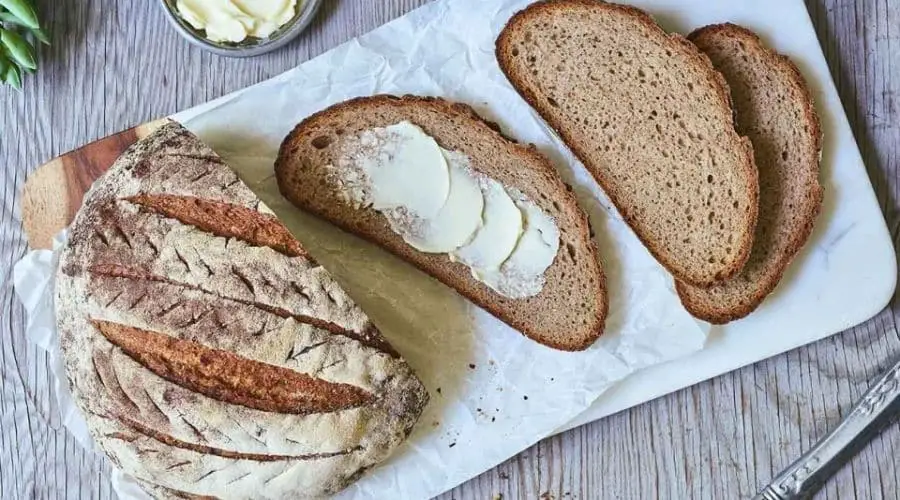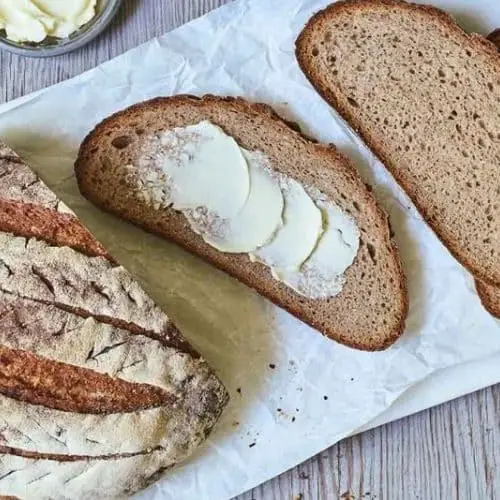All products are selected by our editorial team for quality. If you buy through our links, we may earn a small commission at no extra cost to you.
Sourdough is one of the oldest forms of bread, dating back thousands of years.
Unlike commercial bread, which relies on store-bought yeast, sourdough is naturally leavened using wild yeast and lactic acid bacteria.
This natural fermentation process gives sourdough its signature tangy flavor, chewy texture, and complex aroma.
Many people prefer sourdough not only for its taste but also for its health benefits.
The slow fermentation process breaks down gluten, making it easier to digest for some individuals.
Sourdough is also known for its long shelf life compared to regular bread.
The acidity from the fermentation helps preserve the loaf, reducing the need for preservatives.
Whether you are new to baking or looking to refine your skills, mastering sourdough is a rewarding journey.
Understanding the basics will help you create a perfect loaf every time.

What is Sourdough?
Sourdough is a type of bread made using a natural fermentation process instead of commercial yeast.
It relies on a wild yeast culture, often called a starter, to help the dough rise.
The starter is a mixture of flour and water that captures wild yeast from the environment.
Over time, it ferments, developing a unique balance of yeast and bacteria.
The fermentation process produces carbon dioxide, which creates air pockets in the dough.
This results in a light and airy texture.
Sourdough’s distinct flavor comes from the lactic and acetic acids produced during fermentation.
These acids not only enhance the taste but also help preserve the bread.
Compared to store-bought bread, sourdough has a more complex structure.
It features a crispy crust and a soft, chewy interior.
How to Make a Sourdough Starter from Scratch

Ingredients Needed
Making a sourdough starter requires only two ingredients.
Flour and water.
Whole wheat or rye flour is often recommended for the initial stages.
These flours contain more natural microbes, which help the fermentation process.
Filtered or non-chlorinated water is best.
Chlorine can inhibit yeast growth.
Step-by-Step Process
Day 1: Mixing the Starter
In a clean glass jar or container, mix equal parts flour and water.
Stir until smooth.
Cover loosely with a lid or cloth.
Let it sit at room temperature for 24 hours.
Day 2: Checking for Activity
After a day, you might see small bubbles forming on the surface.
This is a sign that the wild yeast is beginning to activate.
Stir the mixture.
Discard half of it.
Feed it again with fresh flour and water in the same ratio.
Days 3-5: Feeding and Fermentation
Continue feeding the starter daily.
Each time, discard half and add fresh flour and water.
By day four or five, the mixture should have more bubbles.
It should also have a slightly tangy smell.
You may notice it rising and falling between feedings.
Day 6-7: A Fully Active Starter
By the end of the first week, your starter should double in size a few hours after feeding.
It should have a pleasant, slightly sour aroma.
If it does, it is ready to use for baking.
Signs of a Healthy Starter
A healthy sourdough starter should have a bubbly texture.
It should give off a mild tangy scent.
It should rise noticeably after each feeding.
If it smells unpleasant or has mold, it may need to be restarted.
Troubleshooting Common Issues
If the starter isn’t bubbling, it may need a warmer environment.
Keep it in a spot around 70-75°F for best results.
If it develops a dark liquid on top, this is called hooch.
It means the starter is hungry.
Stir it back in or pour it off before feeding again.
With patience and consistent feeding, your sourdough starter will become a reliable leavening agent for all your baking needs.
You have not enough Humanizer words left. Upgrade your Surfer plan.
Essential Tools & Ingredients for Baking Sourdough
Flour
The type of flour you use affects the texture, flavor, and fermentation of your sourdough.
Whole wheat flour provides more nutrients for fermentation and gives the bread a nutty flavor.
Rye flour is highly active in fermentation and can help strengthen a sourdough starter.
All-purpose flour can be used but may require more care to develop gluten properly.
Water
Water quality is important for maintaining a healthy starter and dough fermentation.
Filtered or non-chlorinated water is best, as chlorine can inhibit yeast and bacteria growth.
Salt
Salt enhances the flavor of sourdough and helps control the fermentation process.
Fine sea salt or kosher salt dissolves easily in the dough.
Avoid using iodized salt, as it can interfere with yeast activity.
Starter
A strong, active sourdough starter is essential for a successful loaf.
It should be bubbly, slightly tangy, and able to double in size after feeding.
Must-Have Tools
A digital scale ensures precise measurements, which is crucial for consistent results.
A mixing bowl is needed for combining ingredients and bulk fermentation.
A bench scraper helps handle sticky dough and makes shaping easier.
A proofing basket (banneton) supports the dough during the final rise and gives it a structured shape.
A Dutch oven creates the perfect environment for baking by trapping steam, which helps develop a crispy crust.
A lame (bread scoring tool) is used to make cuts on the dough before baking, allowing it to expand properly in the oven.
A cooling rack prevents the bottom of the loaf from becoming soggy after baking.
The Perfect Sourdough Recipe: Step-by-Step Instructions
Ingredients
- 500g bread flour
- 350g water (plus extra if needed)
- 100g active sourdough starter
- 10g sea salt
Mixing the Dough
In a large mixing bowl, combine the flour and water.
Mix until no dry flour remains.
Let it rest for 30–45 minutes to allow the flour to hydrate.
This step is called autolyse and helps with gluten development.
Add the sourdough starter and salt.
Use your hands to incorporate them into the dough until fully combined.
Bulk Fermentation & Stretch-and-Fold Technique
Cover the dough and let it rest at room temperature for 4–6 hours.
Every 30 minutes, perform a stretch-and-fold.
Gently grab one side of the dough, stretch it upward, and fold it over itself.
Rotate the bowl and repeat this process on all sides.
This strengthens the dough and improves structure.
By the end of bulk fermentation, the dough should have risen noticeably and appear smooth and elastic.
Shaping the Dough
Lightly flour your work surface and turn out the dough.
Gently shape it into a round or oval shape, depending on your preference.
Let it rest for 15–20 minutes before the final shaping.
Tighten the shape by folding the edges toward the center and flipping it over.
Place the shaped dough into a proofing basket lined with a floured cloth.
Proofing the Dough
Cover the dough and let it proof at room temperature for 1–2 hours.
For better flavor and texture, refrigerate it overnight for a cold fermentation.
This slows down fermentation, enhancing the tangy flavor and improving gluten strength.
Scoring and Baking
Preheat your oven to 475°F (245°C) with a Dutch oven inside.
Once hot, turn the dough onto parchment paper.
Use a lame or sharp knife to score the surface.
This allows the bread to expand while baking.
Transfer the dough into the hot Dutch oven.
Cover and bake for 20 minutes.
Remove the lid and bake for another 20–25 minutes until golden brown.
Cooling and Storing Sourdough
Let the bread cool on a wire rack for at least an hour before slicing.
This prevents a gummy texture inside.
Store sourdough at room temperature in a paper bag or wrapped in a clean cloth.
For longer storage, freeze slices and toast them as needed.
Common Sourdough Problems & How to Fix Them
Dense or Gummy Crumb
If your sourdough has a dense or gummy texture, it might be undercooked or under-proofed.
Ensure that the dough has risen sufficiently during the bulk fermentation phase.
Check that your oven temperature is correct, as an oven that’s too cool can prevent proper baking.
Make sure the bread has cooled completely before slicing, as cutting too early can result in a gummy texture.
Weak Rise or Spreading
A weak rise or dough that spreads too much during baking could be a sign of over-proofing or an inactive starter.
Ensure your starter is bubbly and active before use.
Avoid over-fermenting the dough, especially if it’s left at room temperature for too long.
Adjust the proofing time and temperature to suit the dough’s activity levels.
Over-proofed or Under-proofed Dough
If the dough is over-proofed, it will collapse easily and result in flat bread.
To prevent this, check the dough regularly during the proofing phase and don’t let it rise too much.
For under-proofed dough, try allowing for longer fermentation times or adjusting the temperature.
Ensure the dough is fully hydrated and shaped well before proofing for even expansion.
Uneven Crust or Too Thick
If the crust is too thick or uneven, the dough may not have had enough steam in the oven.
Baking in a Dutch oven can help trap steam, which creates a crispy, even crust.
Ensure the oven is preheated properly, and use a spritz of water on the bread before baking for extra steam.
Overly Sour Flavor
If your sourdough is too sour, it could be due to over-fermentation or a starter that’s too acidic.
To reduce the sourness, shorten the fermentation time or adjust the ratio of starter to flour in your dough.
You can also feed your starter more regularly to keep it from becoming overly acidic.
Conclusion
Baking sourdough is both an art and a science.
With practice and patience, you’ll learn to troubleshoot common issues and perfect your technique.
Don’t be discouraged by setbacks—each loaf brings you closer to mastering the process.
The reward is worth the effort: a beautiful, tangy loaf with a chewy interior and a crispy, golden crust.
Keep experimenting, and soon you’ll be baking sourdough like a pro!
Frequently Asked Questions
1. How long does sourdough starter last?
Sourdough starter can last indefinitely if properly maintained.
Feed it regularly with fresh flour and water to keep it active.
If stored in the refrigerator, you may need to feed it once a week.
2. Can I freeze sourdough bread?
Yes, you can freeze sourdough bread!
Slice it first, then wrap it tightly in plastic wrap or foil before freezing.
Thaw and toast slices for a fresh taste when needed.
3. Why is my sourdough not rising properly?
If your sourdough isn’t rising, your starter may not be active enough, or the dough could be under-proofed.
Check the activity of your starter and adjust fermentation times based on room temperature.
Ensure the dough has enough time to rise before baking.
4. Can I use all-purpose flour for sourdough?
Yes, all-purpose flour can be used for sourdough, but you may need to adjust hydration levels.
For a more flavorful loaf, consider mixing in whole wheat or rye flour.
5. Why is my sourdough crust too hard?
If your crust is too hard, it could be because of overbaking or too much heat in the oven.
Ensure the temperature is accurate and try reducing the baking time or lowering the oven heat slightly.

Sourdough
Equipment
- Digital scale – 1 (for accurate measurements)
- Mixing Bowl – 1
- Bench scraper – 1
- Proofing basket (banneton) – 1
- Dutch oven – 1
- Lame or sharp knife – 1
- Parchment paper (1 sheet)
- Wire rack (1, for cooling)
Ingredients
- 500 g bread flour
- 350 g water
- 100 g active sourdough starter
- 10 g sea salt
Instructions
- Mix the dough: In a large bowl, combine the bread flour and water. Stir until no dry flour remains, then let it rest for 30-45 minutes (autolyse).
- Add starter and salt: After the rest period, add the sourdough starter and sea salt. Mix them into the dough until fully incorporated.
- Bulk fermentation: Cover the dough and let it ferment at room temperature for 4-6 hours. Every 30 minutes, stretch and fold the dough.
- Shape the dough: After bulk fermentation, turn the dough onto a floured surface and shape it into a round or oval loaf.
- Final proofing: Place the shaped dough into a proofing basket and cover it. Let it proof at room temperature for 1-2 hours or refrigerate overnight for a slower fermentation.
- Preheat the oven: Preheat the oven to 475°F (245°C), placing a Dutch oven inside to heat up.
- Score the dough: After proofing, turn the dough out onto parchment paper. Score the top with a lame or sharp knife to allow for expansion during baking.
- Bake: Transfer the dough into the preheated Dutch oven. Cover and bake for 20 minutes, then uncover and bake for another 20-25 minutes until golden brown and crispy.
- Cool and serve: Let the bread cool on a wire rack for at least 1 hour before slicing.
Notes
- Ensure your sourdough starter is active before starting the recipe. It should be bubbly and able to double in size within 4-6 hours of feeding.
- If your dough feels too sticky during shaping, you can lightly flour your hands or the work surface.
- To achieve the best crust, baking in a Dutch oven helps trap steam, which gives the bread a crispy exterior.
- If you prefer a milder sourdough flavor, reduce the proofing time or avoid the overnight refrigeration.

